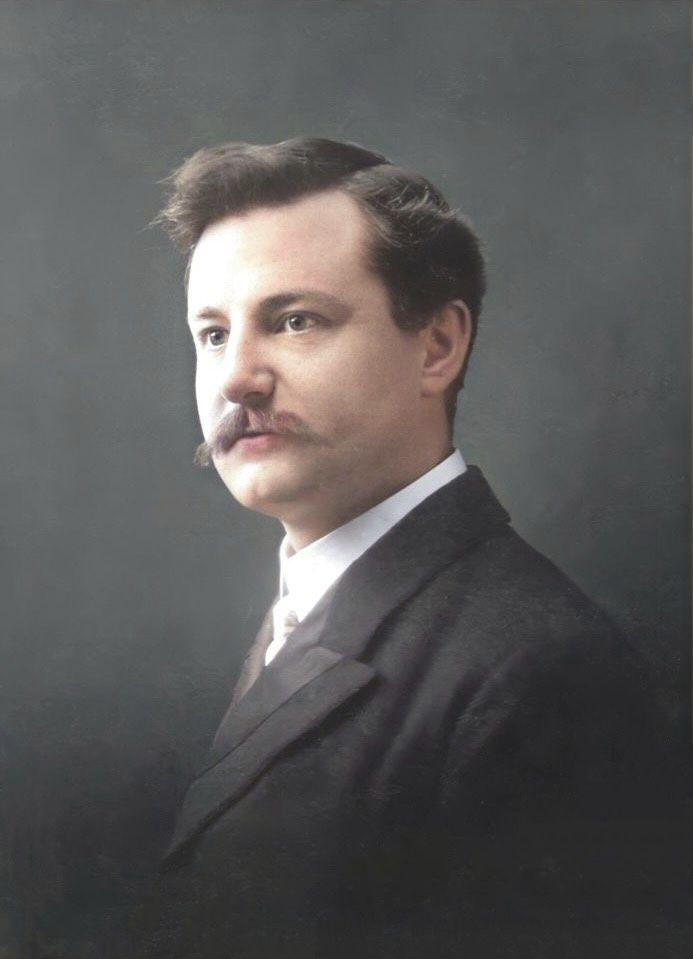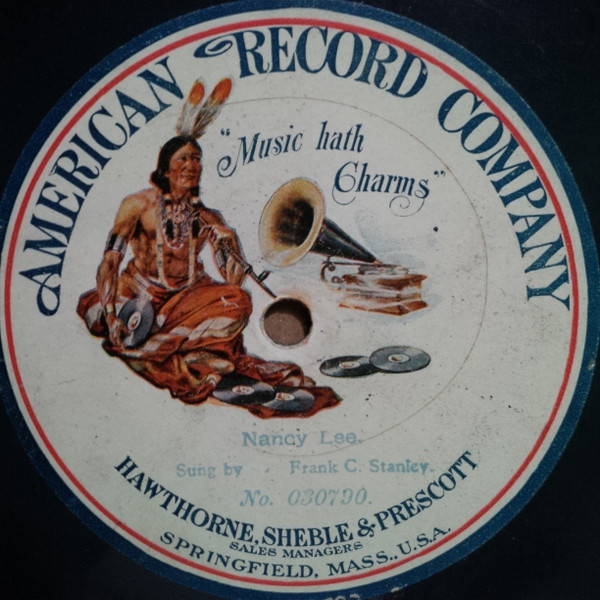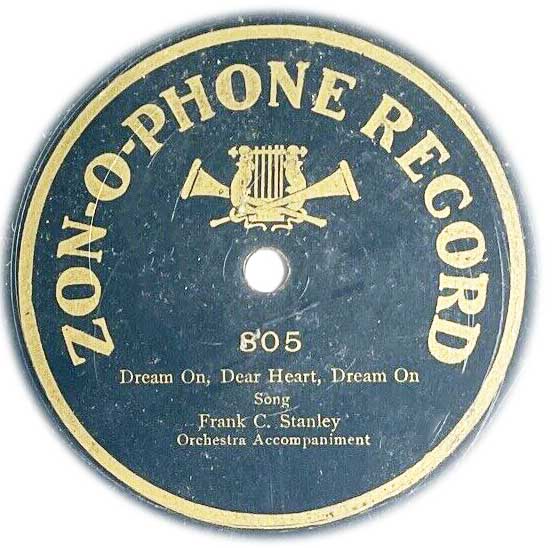In the earliest days of the phonograph, many recording artists were forced to work extra jobs to make a living. None of the workers in the recording industry were protected by unions at this time, so they worked as much as was needed. While most acoustic record collectors would associate Frank C. Stanley with his wonderful skill as a bass singer, he actually started recording much earlier than 1900 and doing something very different. Stanley has the distinction of being one of the first banjoists to be commercially recorded. In addition to having perfect pitch in his voice, he was also an unusually talented banjoist.
He made his first recordings in December of 1891, under his actual name, William Stanley Grinsted. He was only 23 at the time that he made this first batch of cylinders. He was born and raised in Orange, New Jersey, so it shouldn’t come as a surprise that he was discovered by Edison so early on, who was at the time based solely in Orange. He started playing banjo as more of a pastime, as many youths of the late Victorian era did. Unlike many of the other folks his age who took up the banjo, he became quite proficient with the instrument. It is said that when he was in school, he would often bring his banjo with him and entertain his fellow students on their break times. He truly enjoyed playing it, and was quite good at it, so good in fact that someone at the North American Phonograph Company (Edison) thought he would make a great addition to their relatively small catalog. When he joined their talent, Edison was primarily recording Edward Issler and his orchestra in various combinations, and with a few singers occasionally.
He made banjo recordings for a few years for Edison, but soon he left the business to live a more regular life, as recording was not yet seen as a legitimate way to make a living. Not long after he left recording the first time he got a job as a teller at a bank in Orange. In 1894 he married Elizabeth Griffing, and in the subsequent three years they had two children, William and Elizabeth.

He decided to return to Edison in 1898, but this time as a bass singer, of which he was equally talented. A small piece in The Phonoscope dated to summer of 1898 stated upon his return: “Frank C. Stanley, a new aspirant for laurels in the phonograph world, has made a good start.”
It seems that the writers of The Phonoscope at that time were not aware that he had previously been employed by Edison. In addition to working for Edison, when he returned, he also branched out into other smaller record companies, such as that of the Norcross company. Norcross prided themselves by selling only high quality master recordings, no copies. It was also located quite far uptown in Manhattan, at 37th Street and Broadway, which was a bit beyond where the heart of Tin Pan Alley was located. Today this is perilously close to the middle of Times Square.
Upon his return, he didn’t use his actual name as he did back in 1891. He derived his name on records from his middle name of Stanley, but was inspired by Edison’s pianist Frank P. Banta for the first name and three-part structure. Stanley, like many others at Edison, and in the phonograph world in general, really admired Banta, not just for his skill on the piano, but for his kindness and wit. He had likely met Banta right around the beginning of when he started making records, as it was in 1892 that Banta officially became a pianist for Edison (or North American).
Upon his return, he was mostly relegated to recording songs that were standards for baritone and bass singers, generic titles like “God Save the Queen” and “Rocked in the Cradle of the Deep,” but occasionally he would venture out into rag-time songs like “My Honolulu Lady.” It did not take long for him to be paired with other singers, as his voice proved very useful in balancing out many singers that already made records.
 As he became a standard bass singer on a lot of recordings, he did occasionally return to his roots as a banjoist. Between 1899 and 1902, he made about a dozen records with fellow New Jerseyian Arthur Collins. These recordings he made with Collins proved to be remarkably good examples of ragtime on the banjo, as he was not a big star banjoist like Vess Ossman or Ruby Brooks. On most of these records he only accompanied Collins on banjo, but sometimes he also joined in singing with Collins. It is good to know that even while he was more focused on his vocal recording that he still kept up his skill on the banjo.
As he became a standard bass singer on a lot of recordings, he did occasionally return to his roots as a banjoist. Between 1899 and 1902, he made about a dozen records with fellow New Jerseyian Arthur Collins. These recordings he made with Collins proved to be remarkably good examples of ragtime on the banjo, as he was not a big star banjoist like Vess Ossman or Ruby Brooks. On most of these records he only accompanied Collins on banjo, but sometimes he also joined in singing with Collins. It is good to know that even while he was more focused on his vocal recording that he still kept up his skill on the banjo.
On his vocal recordings he was first paired with tenor Byron Harlan, then Harry Macdonough, Henry Burr, Corinne Morgan, Elise Stevenson, and the list goes on. While his solo recordings were brilliant on their own, he was a rock for vocal quartettes, providing the vital bass notes, and always perfectly on pitch. He began singing with the Invincible Quartette, which was the first group to famously bring Arthur Collins and Byron Harlan together. These groups not only recorded the standard fare “barbershop quartette” material, sometimes with piano, but more often without, but they also recorded characteristic sketches. Many such popular quartette sketches were various descriptive scenes of the South. Stanley also was the bass for the Lotus Quartette, whose members still have yet to be fully identified, and much like other studio groups, the personnel changed every once in a while. Some of his best quartette work can be heard on these particular recordings.
 While he was gaining success as a popular singer, he proved to be one of the best singers of sacred songs. From the start of his career he performed these songs to great success. Oftentimes when he recorded these songs, he would be accompanied by a very cheap sounding organ. Obviously these recording studios could not afford full scale pipe organs, so small reed organs were used. This was no coincidence, as toward the middle of his career he became a choir director in Orange, in fact quite a famous one at that. He became known in the community for his talent as a church singer and choir director, and from his records of this genre, it makes sense. People sometimes would come to the church just to hear him sing.
While he was gaining success as a popular singer, he proved to be one of the best singers of sacred songs. From the start of his career he performed these songs to great success. Oftentimes when he recorded these songs, he would be accompanied by a very cheap sounding organ. Obviously these recording studios could not afford full scale pipe organs, so small reed organs were used. This was no coincidence, as toward the middle of his career he became a choir director in Orange, in fact quite a famous one at that. He became known in the community for his talent as a church singer and choir director, and from his records of this genre, it makes sense. People sometimes would come to the church just to hear him sing.
By the middle 1900s he was working what seemed like all the time, making records for every active record company at the time. He also continued to run the local church choir, and manage local community events in Orange; he was also considering getting into politics. If you listen to some of his recordings from 1901 and compare them to his later ones, some of the brilliance of his voice did fade over time, and his relentless work schedule probably was a contributing factor to this. Studio workers were well aware of how valuable and reliable he was as a performer, and with his generally kind and easygoing nature, it became easy to overwork him.
And unfortunately, that’s just what the studios did. In December of 1910, right in the middle of his rising career, he caught a cold and died within two weeks of catching it. Coincidentally, he died much like his first real friend in the recording business, Frank P. Banta, had. Banta in 1903 died of a quick illness that was exacerbated by the amount of work he was doing for the studios. His death was also mourned in a similar way to that of Banta’s. The Edison staff declared an official time of mourning at the very end of 1910 into early 1911.
Though he died at the height of his career, he left a vast number of recordings, allowing us to hear his wonderful voice and banjo playing to this day.
R. S. Baker has appeared at several Ragtime festivals as a pianist and lecturer. Her particular interest lies in the brown wax cylinder era of the recording industry, and in the study of the earliest studio pianists, such as Fred Hylands, Frank P. Banta, and Frederick W. Hager.






















